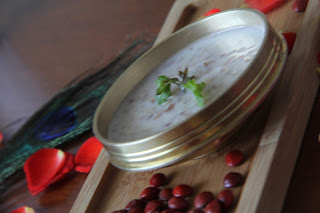With this post, am starting a new series NALA PACHAKAM. I have many male friends who are very good at cooking. Hence I thought of accommodating their contribution as well in my blog. This special payasam recipe is from my friend Madhu. He has shared a few tips as well for making the payasam more delicious. Since i was so keen to share traditional tips, with so much patience he had shared the same. Thank you so much Madhu for sharing this wonderful recfipe.
I prepared this as Naivedyam since palpayasam is a favorite prasadam for lord krishna and Naga devatas.
Ingredients
Unakkalari - 1 cup
Milk - 3 Litre
Sugar - 1 cup or 1 1/4 cup(Depending on your taste)
Kadali pazham (small plantain kerala) - 2 No,s
Tulsi leaves - 1 Kizhi (bundle)
Preparation
Thoroughly wash the rice, drain and keep it aside. In a heavy bottomed pan, (back in kerala we use brass uruli) pour the milk and bring it to boil on a low flame. Add the rice in the boiling milk and let it cook on a low flame again, continuously stirring with a spatula, will take time more than one hour. we have to be patient. At this time take a handful of fresh tulsi leaves and place it in a small tidy cotton cloth and make a bundle in malayalam we call kizhi . and put the same in boiling payasam so that the essence and flavor of the leaves will get absorbed into the payasam giving a divine taste. once the rice is cooked well, sugar can be added. Never before because there is always a tendency to harden the rice if we add sugar before its cooked properly, Its time to remove the vessel from the stove when it gets a pale pink colour . and check the constituency as well,
Take two kadali pazham peel it and cut in to small pieces and grind smoothly in a grinder along with a tablespoon of sugar. Add this paste in the payasam and stir well. This adds a unique taste to the palpayasam especially if we are preparing it for Naivedyam. Remove the kizhi from the payasam after squeezing it.
Keralites will always have the tendency to compare the taste with the tastee from prasadams we get from ambalapuzha and Guruvayoor which is heavenly by all means.
Unakkalari
If we strictly follow the customs and traditions, we are not supposed to prepare prasadam or neivedyam with white raw rice since its used exclusively for shradham related rituals. Madhu shared this traditional tip and I personally agree with it/. I also stopped using white rice and instead i am using unakkalari which i am bringing it from kerala. In UAE i dont think its available but as a substitute we can use Srilankan Red rice which is available in flour mills here. we will get almost the taste of unakkalari. Hope you will notice this tip next time when you prepare neivedyam.
Unakkalari Picture
Also in the final stage we are adding kadalipazham smooth paste for a Unique taste
Kadali pazham is the real king in fruits with immense health benefits, No wonder why its being offered to our deities.






































